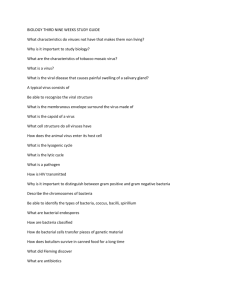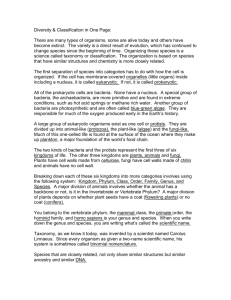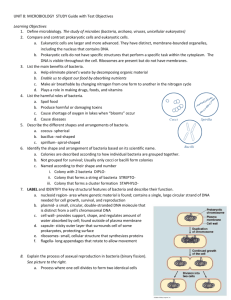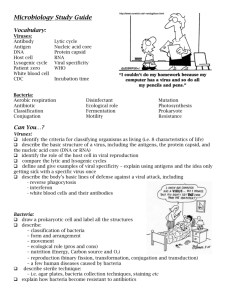Can you guess the structure?
advertisement
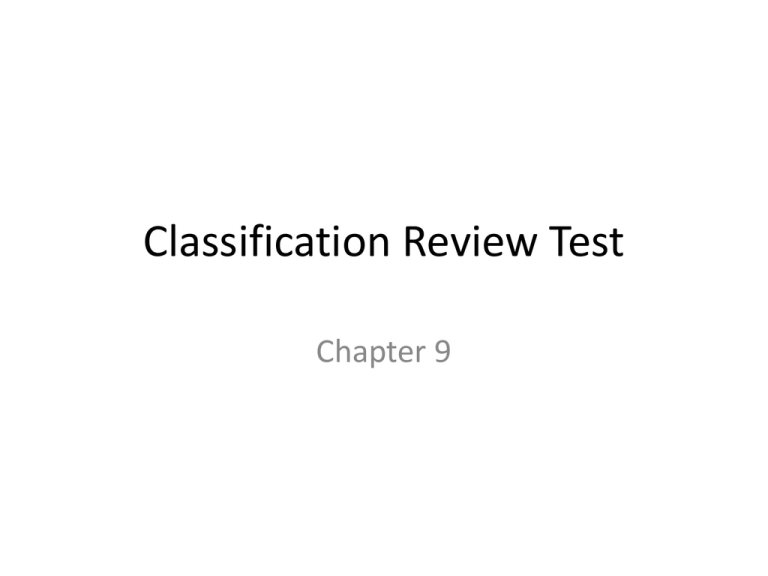
Classification Review Test Chapter 9 1. 2. 3. 4. 5. The two part naming system for classification is called? List the 7 taxa in order. The science of classification What is the term used to describe the evolutionary history of an organism? What term is used to describe an organism that produces its own food? 6. Organisms that obtain nutrients from their environment. 7. What term is used to describe animal-like protists? 8. What organisms are heterotrophs that absorb their food from dead, decaying matter? 9. What kingdom does a paramecium belong to? 10. What is a key that uses two paired statements to identify something called? 11.If two organisms share the same family, what other taxa do they share? 12. These kingdoms contain organisms that are prokaryotic 13.All life on earth is believed to have evolved from this simple life form 14. What are the two main parts of a virus? 15. What are the two types of bacteriophage? 16. What viral cycle results in the destruction of the host cell? 17. A virus needs this in order to reproduce. 18. What does the term lyse mean? 19. What is the main difference between the two viral cycles? 20. What is the term that means asexual reproduction in bacteria? (splitting in two) 21. The hard outer shell that encloses a bacterium in harsh conditions 22. What are the three main shapes of a typical bacterium? 23. What term is used to describe a virus or bacteria that cause diseases? 24.Amoeba have these, also known as false feet. 25.These plant-like protists also have animal-like characteristics. 26. Two types of heterotophic nutrition in bacteria 27. These animal-like protists cannot move on their own and are parasitic. 28. Protozoans are classified based on what? 29.Green, golden, brown, and red algae belong to this kingdom. 30. Seaweed is an example of a protist from this phylum. 31.This part of a paramecium allows it to pump out water. 32.This phylum contains animal-like protists that have cilia 33.These types of protists have flagella. 34.This man developed the method of taxonomy we use today 35.This type of protist has pseudopods. 36. The limited number of hosts a virus can infect is known as this 37.List the four stages in viral replication 38. What are the three main groups of Archaebacteria 39.These bacteria respire in the presence of oxygen. 40.These bacteria obtain their nutrients from dead, decaying matter. 41.Where do chemosynthetic bacteria get the energy needed to make their food? 42.This phylum contains plasmodium which are entirely parasitic. 43.This structure in euglena help them to detect light 3. What is a bacteriophage? Draw a labeled diagram • A bacteriophage is a type of virus that infects bacteria in order to reproduce. This word means “bacteria eater”. 8. Draw an annotated diagram of viral replication (fig.3) 9. How is the lytic cycle of viral replication different from the lysogenic cycle? LYSOGENIC CYCLE LYTIC CYCLE Does not kill the host cell outright Kills the host cell within minutes of infection Viral DNA links with the host’s DNA and replicates as host cell reproduces Viral DNA is replicated by hijacking the host cell Can lie dormant for years causing no apparent symptoms in the host Causes symptoms in the host organism as a result of lysis EX – A temperate phage replicates this way EX. – a virulent phage replicates this way EX – certain cancer -causing viruses replicate this way EX. – The common cold virus replicates this way. Arrangement is then used to identify the bacteria Bacteria are classified according to their shape • Coccus (cocci) are round • Bacillus (bacilli) are rod shaped • Spirillum (spirilla) are spiral shaped Euglena Plant-like Protists PHYLUM DESCRIPTION EXAMPLE EUGLENOPHYTA Fresh water, photosynthetic, also take in solid food, reproduce by binary fission Euglena Chrysophtya Fresh & salt water, autotrophs(chlorphyll), have silica shells Diatoms, golden brown algae Pyrrophyta Autotrophs(chlorphyll) & red pigments , very important in phytoplankton, cause red tides dinoflagellat es Chlorophyta Green algae in fresh water, moist soils, autotrophs(chlorphyll & carotene) –both unicellular & multicellular Green algae spirogyra Phaeophyta Multicellular, autotrophs – contain chlorphyll and fucoxanthin (brown pigment) Seaweed, kelp Rhodophyta Mostly warmer seawater, dulce (dulse), chlorophyll,carotene and phycobilin Red algae, Irish Moss Animal-like Protists Phylum Description Example Sarcodina Free living (not parasitic), fresh & salt ameba water,move by pseudopods(false feet) Mastigophora Zooflagellates, move by flagella, fresh & salt water, can form cysts Flagellated protozoans Trypanosomes (tse tse fly) Ciliophora Ciliates, most complex , can reproduce by binary fission or sexually Paramecium Sporozoa No means of locomotion – all are parasitic Plasmodium – causes malaria Paramecium Ameba
